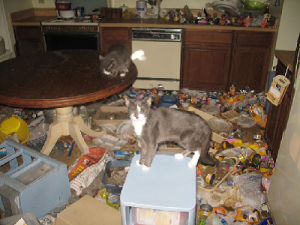 The Mayo Clinic defines “Hoarding Disorder” as a condition where people have a persistent difficulty getting rid of possessions, regardless of actual value, because of a perceived need to save them to such an extent that their living space becomes unusable.
The Mayo Clinic defines “Hoarding Disorder” as a condition where people have a persistent difficulty getting rid of possessions, regardless of actual value, because of a perceived need to save them to such an extent that their living space becomes unusable.
The expansive accumulation of materials range from mild (some rooms are somewhat compromised) to critical (all rooms are filled to capacity and may require a hazmat response).
Without intervention, Hoarding Disorder can interfere with cooking, cleaning, and sleeping leading to issues with personal hygiene and health; access to medical care in emergencies; and safety from fire. More importantly, it could also contribute to loss of life and could endanger anyone living in close proximity to a hoarded structure.


 While not a common occurrence, some people do hoard animals. The keeping of large numbers of animals creates unhealthy environments, which pose a serious threat to the home’s resident(s), animals being kept, and even may affect the surrounding community. Residents become overburdened by the responsibility for these animals and cannot maintain minimal standards of sanitation, nutrition, or veterinary care. This leads to unhealthy waste accumulation, starvation, inbreeding, illness, disease, and even decomposing animal remains. The deterioration of conditions causes health risks for people living in and around hoarded residences, and jeopardizes air quality.
While not a common occurrence, some people do hoard animals. The keeping of large numbers of animals creates unhealthy environments, which pose a serious threat to the home’s resident(s), animals being kept, and even may affect the surrounding community. Residents become overburdened by the responsibility for these animals and cannot maintain minimal standards of sanitation, nutrition, or veterinary care. This leads to unhealthy waste accumulation, starvation, inbreeding, illness, disease, and even decomposing animal remains. The deterioration of conditions causes health risks for people living in and around hoarded residences, and jeopardizes air quality.
 A list of common things that people hoard include:
A list of common things that people hoard include: